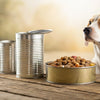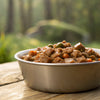How Much Should a 60 lb Dog Eat? A Comprehensive Feeding Guide
- Houndsy
Table of Contents
- Introduction
- Understanding Dog Nutrition
- Feeding Guidelines for a 60 lb Dog
- Meal Frequency and Timing
- Monitoring Your Dog's Weight
- Special Considerations
- Conclusion
- FAQ
Introduction
Have you ever found yourself staring at your dog's food bowl, wondering if you're giving them the right amount? You're not alone. According to the Association for Pet Obesity Prevention, nearly 59% of dogs are classified as overweight or obese. This startling statistic highlights the importance of understanding proper feeding amounts for our furry friends. As responsible pet owners, we want to ensure our dogs receive the right nutrition to maintain their health and vitality.
In this blog post, we will explore the key factors that determine how much food a 60 lb dog should eat. From understanding the implications of portion sizes to recognizing the various factors that influence a dog’s nutritional needs, we aim to equip you with the knowledge to make informed feeding decisions. By the end of this article, you will have a clear understanding of how to tailor your dog’s feeding routine, ensuring it aligns with their specific requirements.
We'll cover essential topics including feeding charts, calorie calculations, the importance of meal frequency, and how to adjust portions for different life stages and activity levels. So, let’s dive in and figure out how we can best nourish our canine companions!
Understanding Dog Nutrition
The Basics of Dog Nutrition
Before we determine how much a 60 lb dog should eat, it’s crucial to understand the basics of dog nutrition. Dogs require a balanced diet that includes proteins, carbohydrates, fats, vitamins, and minerals. Each of these nutrients plays a vital role in maintaining your dog’s health:
- Proteins: Essential for growth, maintenance, and repair of tissues. They also support a healthy immune system.
- Fats: Provide energy, support cell growth, and help absorb certain vitamins.
- Carbohydrates: Offer energy and aid in digestive health by promoting intestinal health through fiber.
- Vitamins and Minerals: Help in various bodily functions, including bone health, immune function, and overall metabolic processes.
When selecting food for your dog, it’s important to choose high-quality ingredients that provide these essential nutrients. Feeding your dog a well-balanced diet will support their overall health and well-being.
Factors Affecting a Dog's Daily Caloric Needs
Determining how much food to feed your dog is influenced by several factors, including:
- Age: Puppies, adults, and senior dogs have different nutritional requirements. Puppies require more calories due to their growth, while seniors may need fewer calories as their activity level decreases.
- Activity Level: Active dogs need more calories to sustain their energy levels, whereas less active dogs require fewer calories to maintain a healthy weight.
- Breed and Size: Larger breeds generally require more food than smaller breeds. However, each dog is unique, and their individual needs may vary.
- Health Status: Dogs with specific health conditions may require special diets or feeding guidelines. Always consult with your veterinarian for tailored advice.
Feeding Guidelines for a 60 lb Dog
Daily Caloric Needs
To determine how much a 60 lb dog should eat, we can start by calculating their daily caloric needs. The general guideline for adult dogs is that they require 30 calories per pound of body weight. For a 60 lb dog, this translates to:
[ 60 , \text{lbs} \times 30 , \text{calories/lb} = 1800 , \text{calories/day} ]
However, this number can vary based on the factors mentioned above. For instance, if your dog is particularly active, they may need more calories, while a less active dog may require fewer.
Using Feeding Charts
Most dog food packaging includes a feeding chart that provides recommended serving sizes based on a dog's weight. These charts are a helpful starting point, but it’s important to remember that they are general guidelines. For a 60 lb dog, the feeding recommendation could range from 2.5 to 4 cups of dry food per day, depending on the calorie content of the specific dog food brand.
Example Feeding Chart for a 60 lb Dog
| Dog Food Brand | Calories per Cup | Cups per Day |
|---|---|---|
| Brand A | 400 | 4.5 |
| Brand B | 350 | 5.1 |
| Brand C | 500 | 3.6 |
Refer to the packaging of your dog’s food for accurate information. If you're switching brands, always ensure you adjust the amount according to the new food's calorie content.
Adjusting Portions Based on Lifestyle
After determining the baseline caloric needs and consulting the feeding chart, you may need to adjust portions based on lifestyle factors:
- Active Lifestyle: If your dog is highly active (e.g., hiking, playing fetch), consider increasing their daily calorie intake by 10-20%.
- Less Active Lifestyle: If your dog leads a more sedentary lifestyle, you may need to decrease their caloric intake by 10-15%.
Regularly monitor your dog's weight and body condition score (BCS) to ensure they maintain a healthy weight.
Meal Frequency and Timing
Importance of Scheduled Feeding
Feeding your dog at consistent times helps regulate their digestive system and can reduce anxiety around mealtime. Most experts recommend feeding adult dogs twice a day: once in the morning and once in the evening. Puppies and active dogs may require more frequent meals.
How to Divide Daily Portions
If you’re feeding a 60 lb dog, and the recommended daily intake is 1800 calories, you can divide this amount based on their meal frequency. For example, if you feed twice a day:
[ \text{Calories per meal} = \frac{1800}{2} = 900 , \text{calories/meal} ]
Using the calorie content of your dog food, you can then convert this to cups. For instance, if the dog food contains 400 calories per cup:
[ \text{Cups per meal} = \frac{900}{400} = 2.25 , \text{cups/meal} ]
The Role of Treats
Don't forget to factor in treats when calculating your dog's daily caloric intake. Treats should make up no more than 10% of your dog’s daily calories. If your dog is receiving a lot of treats, you may need to adjust their main meal portions accordingly.
Monitoring Your Dog's Weight
Understanding Body Condition Score (BCS)
The Body Condition Score is a useful tool for assessing whether your dog is at a healthy weight. It typically ranges from 1 (underweight) to 9 (obese), with a score of 4-5 considered ideal. You should regularly evaluate your dog’s BCS and adjust their food intake as needed.
Signs of Overweight or Underweight
- Overweight: Difficulty in feeling ribs, a noticeable belly, or lethargy.
- Underweight: Prominent ribs and spine, lack of muscle mass, or low energy levels.
If you notice any changes in your dog's weight or overall health, consult your veterinarian for tailored advice on adjusting their diet.
Special Considerations
Puppies and Senior Dogs
- Puppies: They require more calories than adult dogs, often needing 2-3 times the calories per pound of body weight than adults. A 60 lb dog at maturity may need about 990 calories/day as a puppy.
- Senior Dogs: As dogs age, their metabolism may slow down, and they may require fewer calories. Monitor your senior dog’s weight and adjust portions accordingly.
Health Conditions
If your dog has specific health conditions (e.g., diabetes, kidney disease), it’s essential to consult your veterinarian for dietary recommendations tailored to their needs.
Conclusion
Feeding your 60 lb dog the right amount of food is crucial for their health and well-being. By understanding their caloric needs, using feeding charts, and considering factors like activity level and health status, we can provide the best nutrition possible.
Remember to regularly monitor your dog's weight and body condition, adjusting their portions as needed. Consistent feeding schedules and high-quality food will help ensure our furry companions lead happy, healthy lives.
If you are looking for a convenient and stylish way to feed your dog, consider exploring the Houndsy Kibble Dispenser. With its perfect portion control and modern design, it can elevate your dog feeding experience while ensuring your pet is well-fed.
FAQ
1. How much should I feed my 60 lb dog daily? For a 60 lb dog, the general recommendation is around 1800 calories per day, or approximately 2.5 to 4 cups of dry food, depending on the food's calorie content.
2. How do I know if my dog is overweight? Monitor your dog's Body Condition Score (BCS). If you cannot easily feel their ribs or if they have a noticeable belly, they may be overweight. Consult your veterinarian for guidance.
3. Can I feed my dog homemade food? Yes, but it’s essential to consult a veterinary nutritionist to ensure that the homemade diet meets all of your dog’s nutritional needs.
4. How often should I feed my dog? Most adult dogs should be fed twice a day, while puppies may require 3-4 meals throughout the day.
5. What should I do if my dog is underweight? If your dog is underweight, consult your veterinarian to create a tailored feeding plan that increases their caloric intake while ensuring they receive a balanced diet.













